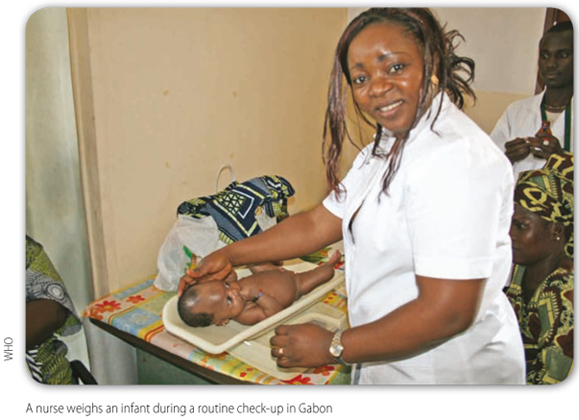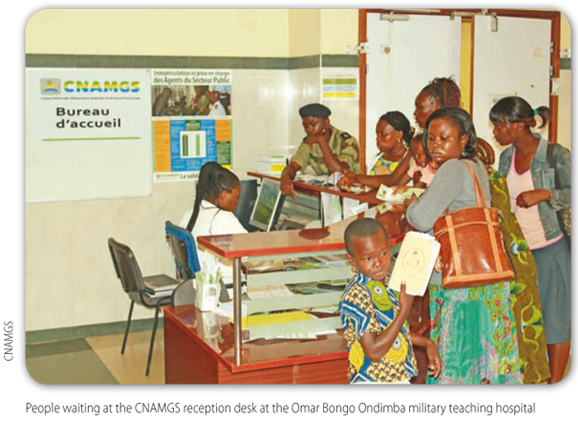NEWS
Gabon gets everyone under one social health insurance roof
Gabon's comprehensive health insurance system is attracting virtually all of its citizens, but to be sustainable it will need to get costs under control. Gary Humphreys reports.
Michel Mboussou, who heads Gabon's National Health Insurance and Social Welfare Fund, has every reason to be a happy man.
During his tenure, as director-general of the Caisse Nationale d'Assurance Maladie et de Garantie Sociale (CNAMGS) in this Central African country, he has seen the steady extension of health-care coverage to the country's different socioeconomic groups, bringing everyone under one social health insurance roof.
When the CNAMGS was launched in 2008, it started to extend coverage to Gabon's poorest people, including students and the elderly. In 2011, coverage was extended to public sector workers. This year it has started providing coverage to private sector workers, previously covered by the Caisse Nationale de Sécurité Sociale (National Social Security Fund), which is being wound down. "We began registration of private sector workers in March and the process will probably be completed this year," says Mboussou.
When Gabon finally completes the last phase in the roll-out of social health insurance expected to happen this year or next it will be a major step towards bringing to a close four decades of hit-and-miss attempts to meet the health needs of the country's 1.5 million people.

At independence in 1960, the government pledged to make health care available to all citizens free of charge at the point of access, but health-care provision for the poor remained inadequate.
Such efforts were spurred globally by the health-for-all declaration in 1978 and, most recently, in 2011, when countries pledged to increase access to health care and decrease out-of-pocket payments as they move towards universal health coverage.
In Gabon, the poor were initially slow to take up the chance to be covered by social health insurance but, by 2011, 417 118 of them just short of the 546 125 eligible beneficiaries identified in a 2008 national census were signed up. "It seemed too good to be true. At first, people didn't believe that they would be looked after," says "Elodie" (not her real name), a 20-year-old student at Omar Bongo Ondimba University in the capital, Libreville.
"But things have changed now because there has been a lot of publicity and, also, because people talk to each other," she explains. For her part Elodie has told all her friends about some dental work she had done. "The procedure would have cost CFA 90 000 (US$ 180), but I paid only CFA 15 000."
Extending coverage to the poorest members of society is something that low- and middle-income countries struggle to do, especially in sub-Saharan Africa.
So far, only a few countries in Africa have achieved anything like the same coverage level through a social health insurance scheme. Ghana, for example, is funding its system with a 2.5% value added tax, insurance premium payments and a top-up subsidy from government funds. Gabon funds health-care coverage for its poor from a 10% levy on mobile phone companies' turnover, excluding tax, and a 1.5% levy on money transfers outside the country. The levies are known collectively as the redevance obligatoire à l'assurance maladie (ROAM) or mandatory health insurance levy.
"These levies have been a tremendous success," says Dr Inoua Aboubacar, a public health specialist at the World Health Organization (WHO) Country Office in Gabon, pointing out that overall resources for the CNAMGS (pronounced "knam-jay-ess") almost quadrupled from CFA 12.5 billion (US$ 25 million) in 2008 to just over CFA 47 billion in 2011, of which CFA 17.5 billion were via this levy system.
"It was largely because of these levies that we were able to start extending social health insurance to poor Gabonese," explains Mboussou. Another reason was that since previous attempts to cover the poor had largely failed, the CNAMGS was starting from an institutional clean slate.
Transferring public sector workers from the Caisse Nationale de Garantie Sociale (National Fund for Social Protection) before liquidating the fund was also relatively straightforward, since it was a separate, functional unit and, of course, government run.
Transferring the private sector workers from the Caisse Nationale de Sécurité Sociale has been less straightforward, partly because it has also meant a tricky transfer of responsibility for hospital care and has involved stakeholders outside the government i.e. private sector employees, the main contributing group not all of whom were convinced of the wisdom of the move.
"The employers needed to be convinced that the CNAMGS was viable and that their contributions were not going to be used to subsidize the country's poor," Mboussou says.
The CNAMGS is promoted under the banner "solidarity makes sense" but, in this case solidarity does not refer to cross-subsidy, as it is divided into three separate funds. The fund covering Gabon's poor is financed with revenue derived from the ROAM mandatory health insurance levies; the one for public sector workers, by contributions paid by public sector employers funds, while the fund for private sector workers, by a payroll tax on employers and employees.
The solidarity refers to the fact that all groups covered by the CNAMGS public sector workers, private sector workers and poor receive the same package of benefits. This package comprises outpatient care that includes medical consultation, nursing and diagnostic services, comprehensive basic maternal health-care services and hospital care, covering a broad range of procedures.
Where the principle of solidarity perhaps breaks down is in the way reimbursement is organized. The CNAMGS provides 100% coverage only for maternal health care. The cost of other medical interventions on offer are 80% reimbursed and 90% reimbursed in the case of chronic conditions, leaving patients to fund the 20% or 10% difference. These so-called "co-payments" are a clear barrier to the poor accessing more costly care.

Such concerns, however, do not detract from the overall achievement of the national fund. "Now people come in for care, people who would not have come in before," says Oceane Andeme (not her real name), a doctor working at a busy public hospital in Libreville. "I see construction workers, house cleaners and even unemployed people coming in for care."
The extension of health-care coverage to Gabon's poor is expected to have a significant impact on their health in the coming years. But if there is to be a happy ending to this particular success story, it is clear that the CNAMGS is also going to have to address some financial sustainability issues in the coming years, notably with regard to the spiralling costs of care.
"Certainly costs need to be kept under control and there is still work to be done in terms of reducing the co-payments or modulating them according to the members' ability to pay," said Riku Eloivainio, a health economist at the WHO headquarters in Geneva. "But the CNAMGS represents a major step forward because, at the end of the day, those now covered by it have better access to health services making them healthier and wealthier."
Spending on family services, which include a family allowance and maternal health care, for example, went from CFA 1.3 billion (US$ 2.6 million) in 2008 to CFA 9.5 billion in 2011, while spending on general health-care coverage for the poor jumped from CFA 447 million in 2009 to CFA 6.3 billion in 2011.
"One explanation for the growth in spending is clearly the increase in registrations by the poor, but the tripling of expenditure between 2010 and 2011 took place in a year when registrations of this group of Gabonese rose just 7% in the same period," notes WHO's Aboubacar.
The CNAMGS's use of fee-for-service as the main payment mechanism may be to blame, because it is the insurer who is paying, so neither the doctor nor the patient has an incentive to control costs and over-servicing is frequently the result.
Fee-for-service presents a further challenge, in terms of billing and accounting, putting considerable strain on existing capacity which, in Gabon, has thus far been used to deal with the relatively simple task of budgeted resource allocation.
While Mboussou recognizes the challenges presented by fee-for-service payment, he says that the CNAMGS has no immediate plans to abandon the system and that doctors, who are employees of the CNAMGS working within the larger hospitals, are being installed across the country to keep over-servicing in check. But what about the smaller regional hospitals and the clinics where there are no national fund doctors in place? Mboussou hopes that the threat of "excommunication" from the CNAMGS will be sufficient to bring prescribing and servicing in line with best practice.
Moreover, over-servicing is not the only possible abuse of the fee-for-service mechanism system. There is also fraud in the form of fictitious billing and overbilling, both of which have been identified as significant problems for the national fund and, already, where such cases have been uncovered by the service in charge of medical services control that fights fraud, sanctions have been imposed.
Here too Mboussou is relatively serene. "The CNAMGS is not the first health insurance system to be confronted with these problems," he says, "and we already have the mechanisms in place to deal with them. It's just a matter of enforcing the rules." 
